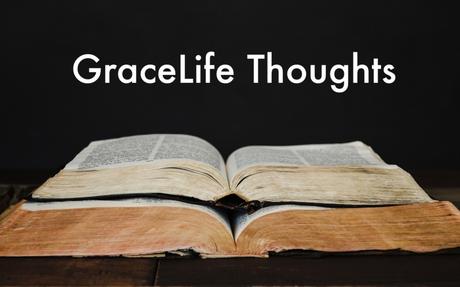Grace Thoughts
GraceLife Thoughts – Questions about the Canon (Part 5)

One of the earliest canons of Scripture was developed by Marcion of Sinope during the early part of the 2nd century AD. It included 10 Letters of Paul (excluding the Pastoral Epistles and adding epistles to the Alexandrians and the Laodiceans) and Marcion’s own version of Luke’s Gospel. Marcion rejected the entire Old Testament and writings of apostles other than Paul and preached a theology that disturbed many Christians of his time (a type of gnosticism), but his effort to determine the canon of Scripture seems to have led other Church leaders to develop a full canon of Scripture in response.
The Pauline Epistles and other Apostolic writings were circulating throughout the Church during the second half of the 1st century AD. Even though Marcion accepted only Luke’s Gospel and 10 of Paul’s Letters as Scripture, most Church leaders regarded the four Gospel accounts, the Book of Acts, and the Writings of Christ’s Apostles as Scripture (in addition to the Hebrew Bible).
The Muratorian fragment (dating to the end of the 2nd century AD) demonstrates that the Church was using the 27 Books of the New Testament by that time, even though some of what Christians have in their Bibles today was disputed for some time. Those Books were called antilegomena, which is Greek for written texts where there were questions of authenticity or value. Homologoumena were accepted texts. Notha were rejected texts. We’ll look at those texts in more depth when we reach our study about how the Church canonized the New Testament.
The Chester Beatty Papyri, believed to date from the 3rd century AD (Ante-Nicene), contains 11 Greek manuscripts: portions of several Old Testament Books, 3 New Testament Books, and 1 with the Book of Enoch and a Christian homily. The Old Testament manuscripts are codices (texts in book form) and contained portions of Genesis, Numbers, Deuteronomy, Isaiah, Jeremiah, Ezekiel, Daniel, Ecclesiastes, and Esther.
The Bryennios List, written in Koine Greek, is dated to the beginning of the 2nd century AD and includes Genesis, Exodus, Leviticus, Jesus Nave (Book of Joshua), Deuteronomy, Numbers, Judges, Ruth, Samuel and Kings, Chronicles, Esdras (Greek version of the Book of Ezra-Nehemiah), Esther, Psalms, Proverbs, Ecclesiastes, Song of Songs, Job, Minor Prophets, Isaiah, Jeremiah, Ezekiel, and Daniel.
Bishop Melito of Sardis lived during the 2nd century AD and compiled an early Christian canon of the Old Testament after traveling to Palestine. Those Books included – Genesis, Exodus, Leviticus, Numbers, Deuteronomy, Joshua, Judges, Ruth, Kings, Chronicles, Psalms of David, Proverbs of Solomon (also called the Book of Wisdom), Ecclesiastes, Song of Songs, Job, Isaiah, Jeremiah, Daniel, Ezekiel, Minor Prophets (in one Book), and Esdras (Ezra-Nehemiah).
Origen of Alexandria was a Christian scholar and theologian of the early 3rd century AD (Ante-Nicene). He viewed the 22 Books of the Old Testament as Scripture. Bishop Eusebius of Caesarea was a leading Christian scholar and historian at the time of the Council of Nicaea (Nicene) and believed in the authenticity of the 22 Books as making up the Old Testament. So did Jerome of Stridon who was a leading Christian scholar of the late 4th century AD (Post-Nicene). Jerome translated the Bible from Hebrew and Greek into Latin (Vulgate) and wanted to limit the Old Testament to the Hebrew 22. However, Bishop Damasus of Rome wanted all of the traditionally-used books, so the Vulgate has 46.
Other 4th century AD Christian leaders who cited the 22 Book Old Testament Canon included Hilary of Poitiers, Cyril of Jerusalem, Gregory of Nazianzus, and Athanasius. The Council of Laodicea in 364 AD restricted the readings in church meetings to only Books of the Old and New Testaments. The Council’s canon of the Old Testament included – Genesis, Exodus, Leviticus, Numbers, Deuteronomy, Joshua, Judges, Ruth, Esther, Kings, Chronicles, Esdras (Ezra-Nehemiah), Psalms, Proverbs, Ecclesiastes, Song of Songs, The Twelve Prophets, Isaiah, Jeremiah-Baruch-Lamentations and the Epistle, Ezekiel, and Daniel.
The views of Jerome and others of the 4th century AD were not held by all Christian leaders of that time. The Synod of Hippo (North Africa) in 393 AD approved an Old Testament canon that included deuterocanonical books. One of the leaders of that Synod was Augustine of Hippo. Augustine was a teacher of rhetoric in the late part of the 4th century AD. He taught at Thagaste, Carthage, Rome, and Milan. It was in Milan in 386 AD that Augustine converted to Christianity and was baptized by Bishop Ambrose. Augustine returned to Africa and was ordained to the ministry in 391 AD and became Bishop of Hippo in 395 AD. He served there until 430 AD. Augustine believed that the deuterocanonical books of the Greek Bible were Scripture and played a major role in the canonizing of the Septuagint.
The Synod of Hippo in 393 AD issued a canon of the Bible that included: Genesis, Exodus, Leviticus, Deuteronomy, Joshua, Judges, Ruth, 1-4 Kings, 1-2 Chronicles, Job, Tobias, Judith, 1-2 Maccabees, 1-2 Esdras, Psalms, Proverbs, Song of Solomon, Ecclesiastes, Wisdom, Sirach, Twelve Minor Prophets, Isaiah, Jeremiah, Daniel, and Ezekiel.
The Council of Carthage in 397 AD issued a canon of the Bible that included: Genesis, Exodus, Leviticus, Numbers, Deuteronomy, Joshua son of Nun, Judges, Ruth, 4 books of Kingdoms, 2 books of Chronicles, Job, the Davidic Psalter, 5 books of Solomon, 12 books of Prophets, Isaiah, Jeremiah, Daniel, Ezekiel, Tobias, Judith, Esther, 2 books of Ezra, and 2 books of Maccabees.
As you can see from this brief history of how the early Church viewed the Old Testament Canon, Christian leaders were concerned that all of God’s Word was included in the life of the Church and believers. The disagreements about which Books were Scripture and which were not continued for centuries, leading to the many versions of the Bible used today by Christians around the world.
Scripture taken from the New King James Version®. Copyright © 1982 by Thomas Nelson. Used by permission. All rights reserved.
GraceLife © 1990-2024
 Bible StudyCanonChristianityDeuterocanonicalJesus Christ
Bible StudyCanonChristianityDeuterocanonicalJesus Christ

Published by gracelifethoughts
Founder & Director of GraceLife Ministries View all posts by gracelifethoughts
